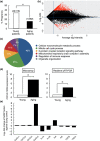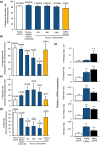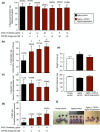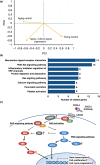CXCL5-CXCR2 signaling is a senescence-associated secretory phenotype in preimplantation embryos
- PMID: 32959976
- PMCID: PMC7576282
- DOI: 10.1111/acel.13240
CXCL5-CXCR2 signaling is a senescence-associated secretory phenotype in preimplantation embryos
Abstract
Pregnancy rate of women decreases with age due to declining quality of oocytes and embryos. However, there is no established method to improve pregnancy rate in aging women. In this study, we identified a senescence-associated secretory phenotype (SASP) factor partially responsible for the decline in embryo implantation potential. Based on microarray analysis using young and aging human embryos at the same morphological grade, 702 genes showed >fivefold increases in aging human blastocysts. Among these genes, C-X-C motif chemokine 5 (CXCL5) showed 7.7-fold increases in aging human blastocysts. However, no-age-dependent changes in expression of the CXCR2, the cognate receptor for CXCL5, were found. In aging mice, Cxcl5 transcript levels were also increased in oocytes and embryos. Treatment of young mouse embryos with CXCL5 decreased implantation rates, together with increased expression of aging markers (P53, P21, Pai-1, and Il-6). Moreover, CXCL5 treatment suppressed trophoblast outgrowth in young mouse blastocysts. Conversely, suppression of CXCL5-CXCR2 signaling in aging mouse embryos using neutralizing antibodies and a receptor antagonist improved the implantation rate, leading to increases in pregnancy and delivery of normal pups. The gene expression pattern of these embryos was comparable to that in young mouse embryos showing enriched cell proliferation-related pathways. In conclusion, we identified CXCL5 as a SASP factor in human and mouse embryos and suppression of CXCL5-CXCR2 signaling during embryo culture improved pregnancy success in aging mice. Future analysis on CXCL5-CXCR2 signaling suppression in human embryos could be the basis to improve embryo development and pregnancy outcome in middle-aged infertile patients.
Keywords: CXCL5; CXCR2; SASP; aging; infertility; preimplantation embryo.
© 2020 The Authors. Aging Cell published by Anatomical Society and John Wiley & Sons Ltd.
Conflict of interest statement
The authors confirm that they have no conflict of interest.
Figures






Similar articles
-
Activation of CXCL5-CXCR2 axis promotes proliferation and accelerates G1 to S phase transition of papillary thyroid carcinoma cells and activates JNK and p38 pathways.Cancer Biol Ther. 2019;20(5):608-616. doi: 10.1080/15384047.2018.1539289. Epub 2018 Nov 7. Cancer Biol Ther. 2019. PMID: 30404567 Free PMC article.
-
Activated CXCL5-CXCR2 axis promotes the migration, invasion and EMT of papillary thyroid carcinoma cells via modulation of β-catenin pathway.Biochimie. 2018 May;148:1-11. doi: 10.1016/j.biochi.2018.02.009. Epub 2018 Feb 20. Biochimie. 2018. PMID: 29471001
-
Human Brain Endothelial CXCR2 is Inflammation-Inducible and Mediates CXCL5- and CXCL8-Triggered Paraendothelial Barrier Breakdown.Int J Mol Sci. 2019 Jan 30;20(3):602. doi: 10.3390/ijms20030602. Int J Mol Sci. 2019. PMID: 30704100 Free PMC article.
-
CXCL5/CXCR2 axis in tumor microenvironment as potential diagnostic biomarker and therapeutic target.Cancer Commun (Lond). 2020 Mar;40(2-3):69-80. doi: 10.1002/cac2.12010. Cancer Commun (Lond). 2020. PMID: 32237072 Free PMC article. Review.
-
Control of senescence by CXCR2 and its ligands.Cell Cycle. 2008 Oct;7(19):2956-9. doi: 10.4161/cc.7.19.6780. Epub 2008 Oct 13. Cell Cycle. 2008. PMID: 18838863 Review.
Cited by
-
Identification of a senescence-related transcriptional signature to uncover molecular subtypes and key genes in hepatocellular carcinoma.PLoS One. 2024 Oct 9;19(10):e0311696. doi: 10.1371/journal.pone.0311696. eCollection 2024. PLoS One. 2024. PMID: 39383169 Free PMC article.
-
Advanced Maternal Age-associated SIRT1 Deficiency Compromises Trophoblast Epithelial-Mesenchymal Transition through an Increase in Vimentin Acetylation.Aging Cell. 2021 Oct;20(10):e13491. doi: 10.1111/acel.13491. Epub 2021 Oct 3. Aging Cell. 2021. PMID: 34605151 Free PMC article.
-
Senolytic treatment for low back pain.Sci Adv. 2025 Mar 14;11(11):eadr1719. doi: 10.1126/sciadv.adr1719. Epub 2025 Mar 14. Sci Adv. 2025. PMID: 40085710 Free PMC article.
-
The Role of Senescence-Associated Secretory Phenotype in Bone Loss.Front Cell Dev Biol. 2022 Feb 9;10:841612. doi: 10.3389/fcell.2022.841612. eCollection 2022. Front Cell Dev Biol. 2022. PMID: 35223858 Free PMC article. Review.
-
Intestinal lymphatic vasculature is functionally adapted to different drainage regions and is altered by helminth infection.J Exp Med. 2025 Sep 1;222(9):e20241181. doi: 10.1084/jem.20241181. Epub 2025 Jun 12. J Exp Med. 2025. PMID: 40505102 Free PMC article.
References
-
- Arenberg, D. A. , Keane, M. P. , DiGiovine, B. , Kunkel, S. L. , Morris, S. B. , Xue, Y. Y. , … Strieter, R. M. (1998). Epithelial‐neutrophil activating peptide (ENA‐78) is an important angiogenic factor in non‐small cell lung cancer. Journal of Clinical Investigation, 102(3), 465–472. 10.1172/jci3145 - DOI - PMC - PubMed
-
- Balamayooran, G. , Batra, S. , Cai, S. , Mei, J. , Worthen, G. S. , Penn, A. L. , & Jeyaseelan, S. (2012). Role of CXCL5 in leukocyte recruitment to the lungs during secondhand smoke exposure. American Journal of Respiratory Cell and Molecular Biology, 47(1), 104–111. 10.1165/rcmb.2011-0260OC - DOI - PMC - PubMed
Publication types
MeSH terms
Substances
LinkOut - more resources
Full Text Sources
Molecular Biology Databases
Research Materials
Miscellaneous

